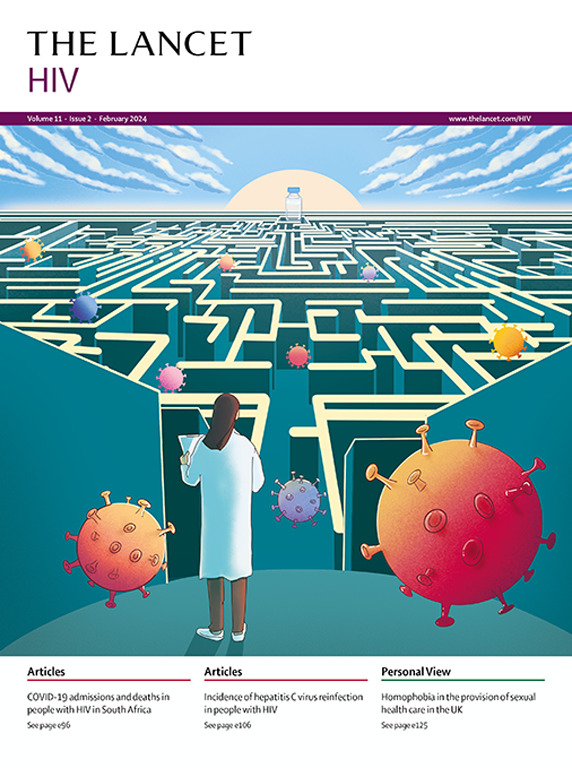Safety and pharmacokinetics of dolutegravir dispersible tablets and oral films in term neonates exposed to HIV in South Africa (PETITE-DTG study): an open-label, randomised, phase 1/2 trial.
IF 13
1区 医学
Q1 IMMUNOLOGY
引用次数: 0
Abstract
BACKGROUND Dolutegravir is not recommended for neonates (age 28 days or younger) due to the absence of dosing guidelines and safety information. We evaluated the multidose pharmacokinetics and safety of two paediatric dolutegravir formulations in neonates: a scored dispersible tablet and a novel oral dispersible film. METHODS We did a phase 1/2, open-label, single-centre, two-stage, randomised trial in neonates at Tygerberg Hospital, South Africa, who were born at term (≥37 weeks gestational age, birthweights ≥2 kg) to pregnant women on dolutegravir-based antiretroviral therapy. Neonates in stage two were randomly assigned (1:1) to receive 5 mg dolutegravir either as half of a scored dispersible tablet (10 mg) or one oral dispersible film (5 mg), administered every 48 h for the first 2 weeks of life, followed by daily up to day 28 of life. Plasma pharmacokinetic samples were collected during three visits: at entry (before and 1-3 h after the first dolutegravir dose); at any time from the third dolutegravir dose but before week 4 of life (before and 1, 2, 4, 6, and 48 h after the dolutegravir dose); and during week 4 of life (before and 1-3 h after the dolutegravir dose). The primary outcomes were dolutegravir pharmacokinetic parameters of area under the concentration time curve (AUC), maximum plasma concentration (Cmax), apparent clearance (CL/F), and trough concentration (Ctrough) in participants who completed intensive pharmacokinetic sampling and occurrence of non-treatment-related and treatment-related adverse events of grade 3 or higher and any adverse events in participants who received at least one dose of dolutegravir. Target pharmacokinetic criteria were geometric mean Ctrough higher than 0·67 μg/mL and individual Cmax lower than 17·0 μg/mL. The trial is registered with ClinicalTrials.gov, NCT05590325. FINDINGS Between Sept 15, 2023, and Nov 6, 2024, 41 neonates were enrolled, randomly assigned, and received dolutegravir (21 [51%] received dispersible tablets and 20 [49%] received dolutegravir films); 25 (61%) neonates were male and 16 (39%) were female. Median birthweight was 3235 g (range 2365-4330) and the first dolutegravir dose was administered at median 47 h (range 22-78) after birth. Intensive dolutegravir pharmacokinetic profiles sampled after at least three doses of dolutegravir (range 6-10 days of life) were similar between the dolutegravir dispersible tablet and the dolutegravir film and the dolutegravir geometric mean area under the concentration time curve (AUC0-48), and CL/F were 193·2 μg x h/mL and 0·026 L/h, respectively. Both formulations attained a dolutegravir geometric mean Ctrough higher than 0·67 μg/mL. All neonates had a dolutegravir Cmax lower than 17·0 μg/mL at every pharmacokinetic visit. No adverse events were related to dolutegravir. Two grade 3 adverse events, the highest severity observed, occurred in one neonate with pneumonia. A total of 22 adverse events occurred in 12 (57%) of the 21 neonates receiving dolutegravir dispersible tablets and 23 adverse events occurred in 14 (70%) of the 20 neonates receiving dolutegravir films. All 39 neonates who completed follow-up were HIV negative at study exit. INTERPRETATION To our knowledge, this is the first evidence providing dolutegravir dosing guidance from birth up to week 4 of life, supporting inclusion into national and international antiretroviral dosing guidelines. FUNDING Unitaid.多替格拉韦分散片和口服薄膜在南非暴露于HIV的足月新生儿中的安全性和药代动力学(PETITE-DTG研究):一项开放标签、随机、1/2期试验。
背景:由于缺乏剂量指南和安全性信息,dolutegravir不推荐用于新生儿(28天或以下)。我们评估了两种小儿多替格拉韦制剂在新生儿中的多剂量药代动力学和安全性:一种记分分散片和一种新型口服分散膜。方法:我们在南非Tygerberg医院进行了一项1/2期、开放标签、单中心、两期、随机试验,研究对象为足月出生(≥37周孕周,出生体重≥2 kg)的孕妇,接受了以曲地韦为基础的抗逆转录病毒治疗。第二阶段的新生儿被随机分配(1:1)接受5mg的多替格拉韦,作为评分分散片(10mg)的一半或口服分散片(5mg),在生命的前2周每48小时给药一次,然后每天给药,直到生命的第28天。在三次访问中收集血浆药代动力学样本:在入药时(首次给药前和服药后1-3小时);从第三次多替韦剂量开始,但在生命第4周之前的任何时间(多替韦剂量之前和剂量后1、2、4、6和48小时);以及在生命第4周(给药前和给药后1-3小时)。主要结果是完成密集药代动力学采样的受试者的多替格拉韦药动学参数浓度时间曲线下面积(AUC)、最大血浆浓度(Cmax)、表观清除率(CL/F)和谷浓度(Ctrough),以及3级或以上非治疗相关和治疗相关不良事件的发生,以及接受至少一剂多替格拉韦治疗的受试者的任何不良事件。靶药动学标准几何平均高于0.67 μg/mL,个体Cmax低于17.0 μg/mL。该试验已在ClinicalTrials.gov注册,编号NCT05590325。在2023年9月15日至2024年11月6日期间,41名新生儿被纳入,随机分配并接受了多路格拉韦治疗(21名[51%]接受了分散片治疗,20名[49%]接受了多路格拉韦片治疗);新生儿中男性25例(61%),女性16例(39%)。中位出生体重为3235 g(范围2365-4330),在出生后中位47小时(范围22-78)给药。多替替韦分散片与多替替韦膜在浓度时间曲线下的几何平均面积(auc0 ~ 48)相似,CL/F分别为193·2 μg × h/mL和0·026 L/h。两种制剂的偏重几何平均浓度均高于0.67 μg/mL。所有新生儿在每次药代动力学访问时都有低于17·0 μg/mL的多替替韦Cmax。未发现与多替韦相关的不良事件。两个3级不良事件,最严重的观察,发生在一个新生儿肺炎。接受多替格拉韦分散片治疗的21例新生儿中有12例(57%)发生了22例不良事件,接受多替格拉韦薄膜治疗的20例新生儿中有14例(70%)发生了23例不良事件。所有39名完成随访的新生儿在研究结束时均为HIV阴性。据我们所知,这是第一个提供从出生到生命第4周的多替格拉韦剂量指导的证据,支持将其纳入国家和国际抗逆转录病毒剂量指南。
本文章由计算机程序翻译,如有差异,请以英文原文为准。
求助全文
约1分钟内获得全文
求助全文
来源期刊

Lancet Hiv
IMMUNOLOGYINFECTIOUS DISEASES&-INFECTIOUS DISEASES
CiteScore
19.90
自引率
4.30%
发文量
368
期刊介绍:
The Lancet HIV is an internationally trusted source of clinical, public health, and global health knowledge with an Impact Factor of 16.1. It is dedicated to publishing original research, evidence-based reviews, and insightful features that advocate for change in or illuminates HIV clinical practice. The journal aims to provide a holistic view of the pandemic, covering clinical, epidemiological, and operational disciplines. It publishes content on innovative treatments and the biological research behind them, novel methods of service delivery, and new approaches to confronting HIV/AIDS worldwide. The Lancet HIV publishes various types of content including articles, reviews, comments, correspondences, and viewpoints. It also publishes series that aim to shape and drive positive change in clinical practice and health policy in areas of need in HIV. The journal is indexed by several abstracting and indexing services, including Crossref, Embase, Essential Science Indicators, MEDLINE, PubMed, SCIE and Scopus.
 求助内容:
求助内容: 应助结果提醒方式:
应助结果提醒方式:


